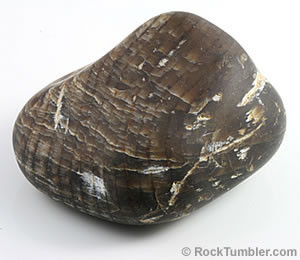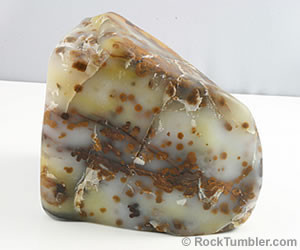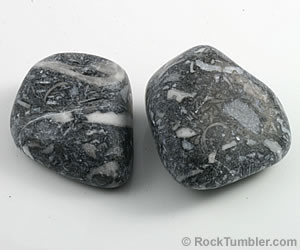Can All Rocks Be Polished? Generally, no, not all rocks can be effectively polished, especially using a rock tumbler; however, at rockscapes.net, we can offer expert advice on rock selection and preparation. The key lies in the rock’s hardness, mineral composition, and presence of fractures. This article will guide you through which rocks are suitable for polishing, alternative methods, and how to achieve the best results. You’ll also learn about identifying rocks with polishing potential, preparing them effectively, and even exploring options like custom lapidary services for those extra-special pieces.
1. Understanding Rock Polishability
The ability to polish a rock depends on several factors, primarily its hardness, mineral composition, and structural integrity. Not all rocks are created equal, and some are simply better suited for polishing than others.
1.1. Hardness Matters
The Mohs Hardness Scale measures a mineral’s resistance to scratching. Rocks with a hardness of 6 or higher on the Mohs scale, such as quartz and agate, are generally good candidates for polishing. Softer rocks, like gypsum (hardness of 2), are difficult to polish because they scratch too easily.
According to research from the Gemological Institute of America (GIA), consistent hardness throughout the rock is crucial for achieving a uniform polish. Rocks with varying hardness levels may polish unevenly, resulting in a less desirable finish.
1.2. Mineral Composition
The minerals that make up a rock also play a significant role in its polishability. Rocks composed of a single mineral, like quartz, tend to polish more predictably than those with multiple minerals. Rocks with diverse mineral compositions can have varying hardness levels and polishing characteristics within the same specimen.
For example, granite, which contains quartz, feldspar, and mica, can be challenging to polish uniformly because these minerals have different hardness levels. The quartz may polish well, while the feldspar and mica might not achieve the same level of shine.
1.3. Structural Integrity
Fractures, cracks, and other internal flaws can prevent a rock from polishing properly. During the tumbling process, these weak points can cause the rock to break apart, especially when subjected to the abrasive action of the grit.
According to a study by the University of Arizona’s Department of Geosciences, rocks with significant fracturing are more likely to disintegrate during tumbling, rendering them unpolishable.
 Petrified wood
Petrified wood
Alt: Fractured petrified wood unsuitable for polishing due to internal cracks.
2. Identifying Rocks with Polishing Potential
Knowing which rocks are likely to polish well is the first step in achieving beautiful, tumbled stones. Look for rocks that are hard, dense, and free of fractures.
2.1. Visual Inspection
Carefully examine the rock for any visible cracks, fractures, or other imperfections. Use a magnifying glass or hand lens to get a closer look. Rocks with a smooth, even texture are generally more likely to polish well than those with a rough, pitted surface.
2.2. Hardness Test
A simple scratch test can help determine a rock’s hardness. Try scratching the rock with a steel nail or a piece of glass. If the rock scratches the steel nail (hardness of 6.5) or glass (hardness of 5.5), it is likely hard enough to polish.
2.3. Common Rocks that Polish Well
Some of the most popular and reliable rocks for polishing include:
- Agate: A variety of chalcedony known for its vibrant colors and banding patterns.
- Jasper: An opaque form of chalcedony that comes in a wide range of colors and patterns.
- Quartz: A common mineral that includes varieties like clear quartz, amethyst, and citrine.
- Obsidian: A volcanic glass that can be polished to a high shine.
- Petrified Wood: Fossilized wood that has been replaced by minerals like quartz.
3. Preparing Rocks for Polishing
Proper preparation is essential for achieving the best possible results when polishing rocks. This involves cleaning, shaping, and removing any rough edges or imperfections.
3.1. Cleaning
Remove any dirt, debris, or loose material from the surface of the rock using a scrub brush and water. For stubborn dirt, you can use a mild detergent or soak the rock in a solution of water and vinegar.
3.2. Shaping
Rocks with sharp edges or irregular shapes should be pre-shaped before tumbling. This can be done using a rock hammer, chisel, or grinding wheel. The goal is to create a smooth, rounded shape that will tumble evenly.
3.3. Removing Imperfections
Use a grinding wheel or diamond file to remove any significant imperfections, such as large pits, cracks, or inclusions. This will help prevent the rock from breaking apart during tumbling and improve the final polish.
4. The Rock Tumbling Process
Rock tumbling is a multi-stage process that involves gradually grinding and polishing the rocks using increasingly finer grits.
4.1. Coarse Grit Stage
The first stage involves tumbling the rocks with a coarse grit (typically 60/90 grit) to remove any remaining rough edges and shape the rocks. This stage can take several days to a week or more, depending on the hardness and shape of the rocks.
4.2. Medium Grit Stage
After the coarse grit stage, the rocks are tumbled with a medium grit (typically 120/220 grit) to smooth the surfaces and remove any scratches left by the coarse grit. This stage usually takes about a week.
4.3. Fine Grit Stage
The fine grit stage (typically 500/800 grit) further smooths the surfaces and prepares the rocks for polishing. This stage typically lasts for several days.
4.4. Polishing Stage
In the final stage, the rocks are tumbled with a polishing compound, such as aluminum oxide or cerium oxide, to create a high shine. This stage can take several days to a week.
According to research from the Industrial Minerals Association – North America, the polishing stage is critical for achieving a professional-quality finish. Using the correct polishing compound and maintaining proper tumbling conditions are essential for maximizing shine.
5. Troubleshooting Common Polishing Problems
Even with careful preparation and a well-executed tumbling process, problems can still arise. Here are some common issues and how to address them:
5.1. Rocks Not Polishing
If your rocks are not polishing, it could be due to several factors:
- Insufficient Grit: Make sure you are using the correct grit for each stage and that you are not skipping any stages.
- Contamination: Contamination from previous stages can prevent the polishing compound from working effectively. Be sure to thoroughly clean the tumbler and rocks between each stage.
- Hardness Issues: The rocks may be too soft or have varying hardness levels.
5.2. Rocks Breaking Apart
Rocks breaking apart during tumbling is usually caused by fractures or weak points in the rock. To prevent this, carefully inspect the rocks before tumbling and remove any that appear to be structurally unsound.
5.3. Uneven Polishing
Uneven polishing can occur if the rocks are not tumbling evenly or if they have varying hardness levels. Make sure the tumbler is properly loaded and that the rocks are all roughly the same size and shape.
6. Alternative Polishing Methods
While rock tumbling is a popular method for polishing rocks, there are other options available, each with its own advantages and disadvantages.
6.1. Lapidary Machines
Lapidary machines use diamond grinding and polishing wheels to shape and polish rocks. These machines offer more control and precision than rock tumblers, making them ideal for polishing delicate or valuable specimens.
6.2. Hand Polishing
Hand polishing involves using abrasive compounds and polishing cloths to manually polish rocks. This method is best suited for small, intricate pieces that cannot be easily tumbled or polished with a machine.
6.3. Vibratory Tumblers
Vibratory tumblers use a vibrating motion to polish rocks, which can be faster and more efficient than rotary tumblers. They are also less likely to damage delicate specimens.
7. The Role of Rockscapes.net in Your Polishing Journey
At rockscapes.net, we’re passionate about helping you unlock the natural beauty of rocks. While not all rocks can be polished using standard methods, we provide the expertise and resources you need to make informed decisions and achieve stunning results.
7.1. Expert Advice on Rock Selection
Our team of experienced geologists and landscape designers can help you select the best rocks for your polishing projects. We can assess the hardness, mineral composition, and structural integrity of your rocks to determine their polishability.
7.2. Guidance on Preparation Techniques
We offer detailed guidance on preparing rocks for polishing, including cleaning, shaping, and removing imperfections. Our step-by-step instructions and video tutorials will help you achieve professional-quality results.
7.3. Connecting You with Custom Lapidary Services
For those special rocks that require expert attention, we can connect you with reputable custom lapidary services. These professionals have the tools and experience to polish even the most challenging specimens.
7.4. Inspiration for Rock-Based Landscaping
Beyond polishing, rockscapes.net is your ultimate source for inspiration and information on using rocks in landscaping. Discover creative ways to incorporate polished and unpolished stones into your outdoor spaces, from stunning rock gardens to elegant water features.
 Polka dot agate
Polka dot agate
Alt: Polka dot agate sample, demonstrating the aesthetic appeal of polished stones.
8. Exploring Landscape Design with Polished and Unpolished Rocks
Rocks, whether polished to a gleaming shine or left in their natural state, can add texture, color, and character to any landscape design.
8.1. Polished Rocks as Focal Points
Use polished rocks as focal points in your garden or landscape. A large, polished boulder can make a stunning statement piece, while smaller polished stones can be used to create eye-catching accents.
8.2. Unpolished Rocks for Natural Beauty
Unpolished rocks offer a raw, natural beauty that can complement any landscape design. Use them to create rock gardens, retaining walls, or natural-looking pathways.
8.3. Combining Polished and Unpolished Rocks
Combining polished and unpolished rocks can create a dynamic and visually appealing landscape. The contrast between the smooth, shiny surfaces of the polished rocks and the rough, textured surfaces of the unpolished rocks can add depth and interest to your design.
9. The Environmental Impact of Rock Polishing
It’s essential to consider the environmental impact of rock polishing and take steps to minimize any negative effects.
9.1. Water Usage
Rock tumbling can use a significant amount of water, especially during the cleaning stages. Conserve water by using efficient tumbling techniques and reusing water whenever possible.
9.2. Grit Disposal
Properly dispose of used grit to prevent it from contaminating soil and water sources. Check with your local waste management authorities for guidelines on disposing of rock tumbling grit.
9.3. Sustainable Sourcing
Choose rocks from sustainable sources to minimize the environmental impact of your polishing projects. Look for rocks that have been collected responsibly and ethically.
10. Staying Up-to-Date with Rock Polishing Trends
The world of rock polishing is constantly evolving, with new techniques, materials, and trends emerging all the time. Stay informed to get the most out of your polishing journey.
10.1. Following Industry Experts
Follow leading experts in the rock polishing and lapidary fields to stay up-to-date on the latest techniques and trends. Look for experts who share their knowledge through blogs, social media, and workshops.
10.2. Attending Workshops and Gem Shows
Attending rock polishing workshops and gem shows is a great way to learn new skills, discover new materials, and connect with other enthusiasts.
10.3. Exploring Online Resources
Numerous online resources, including forums, blogs, and video tutorials, offer valuable information on rock polishing. Take advantage of these resources to expand your knowledge and improve your skills.
 Tumbled ruby
Tumbled ruby
Alt: Tumbled ruby crystals, showcasing the challenges of polishing corundum.
11. Answering Your Burning Questions About Rock Polishing
Here are some frequently asked questions about rock polishing to help you on your way.
11.1. What Types of Rocks Polish Best in a Tumbler?
Hard, dense rocks like agate, jasper, and quartz are ideal for tumbling due to their ability to withstand the abrasive process and achieve a high polish.
11.2. How Do I Identify a Rock That’s Good for Polishing?
Look for rocks that are free of cracks, have a consistent color throughout, and are relatively smooth. A scratch test can also help determine if a rock is hard enough to withstand the polishing process.
11.3. Can I Polish Rocks I Find on the Beach?
Yes, but make sure they are hard enough. Beach rocks are often sedimentary, like sandstone and shale, which are too soft to polish well in a tumbler.
11.4. What Grit Sizes Do I Need for Rock Tumbling?
A standard rock tumbling process typically involves four stages, each requiring a different grit size: coarse (60/90), medium (120/220), fine (500/800), and polish.
11.5. How Long Does Each Stage of Rock Tumbling Take?
Each stage usually takes about a week. However, the coarse stage may take longer if the rocks are particularly rough or need significant shaping.
11.6. Can I Use Dish Soap Instead of Tumbling Soap?
No, regular dish soap can leave a residue that interferes with the polishing process. Tumbling soap is specifically designed to clean rocks without leaving any residue.
11.7. How Do I Know When to Move to the Next Stage?
Examine the rocks closely. If they are smooth and free of any major imperfections, you can move on to the next stage.
11.8. What if My Rocks Aren’t Shiny After Polishing?
This could be due to a number of factors, including contamination, not using enough polish, or using the wrong type of polish. Make sure to clean the rocks and tumbler thoroughly between stages, and use a high-quality polishing compound.
11.9. Can I Polish Soft Rocks Like Obsidian?
Yes, but soft rocks require a more gentle approach. Use a vibratory tumbler and shorter tumbling times to avoid damaging the stones.
11.10. Is It Possible to Over-Tumble Rocks?
Yes, over-tumbling can cause the rocks to become rounded and lose their shape. It can also cause soft rocks to disintegrate.
12. Embrace the Beauty of Rocks with Rockscapes.net
While the answer to “Can all rocks be polished?” is nuanced, the possibilities for transforming rocks into stunning pieces of art are endless. Whether you’re a seasoned rockhound or just starting your journey, rockscapes.net is here to inspire and guide you.
Explore our website for a wealth of information on rock types, polishing techniques, and landscape design ideas. Discover how to bring the natural beauty of rocks into your home and garden.
Ready to transform your rocks into stunning works of art? Visit rockscapes.net today and unlock the beauty of the natural world. You can also visit us at 1151 S Forest Ave, Tempe, AZ 85281, United States, or call us at +1 (480) 965-9011.
 Tumbled marble
Tumbled marble
Alt: Polished fossiliferous marble rocks, showcasing a fantastic transformation of sedimentary stones.